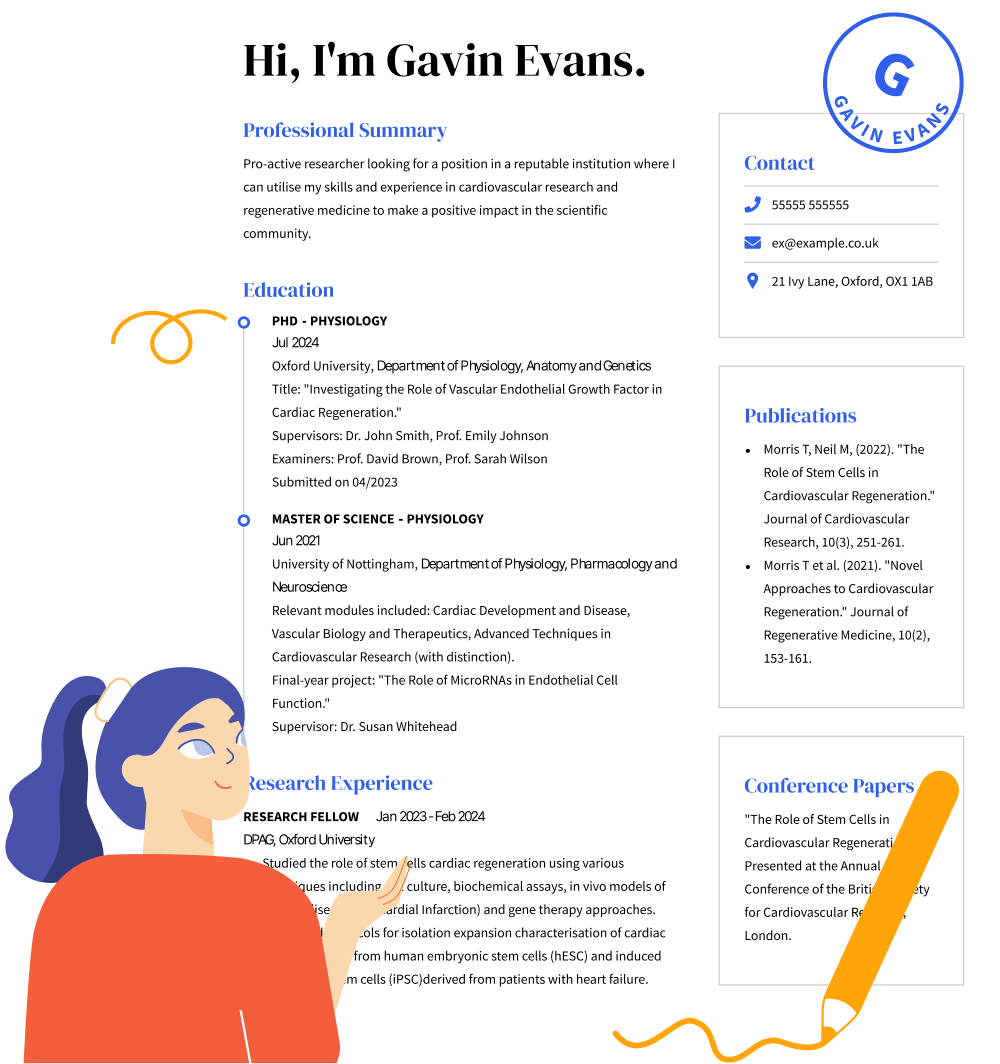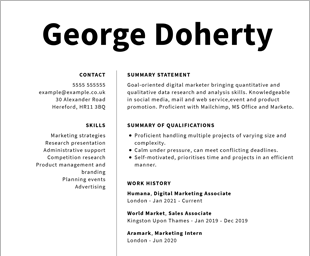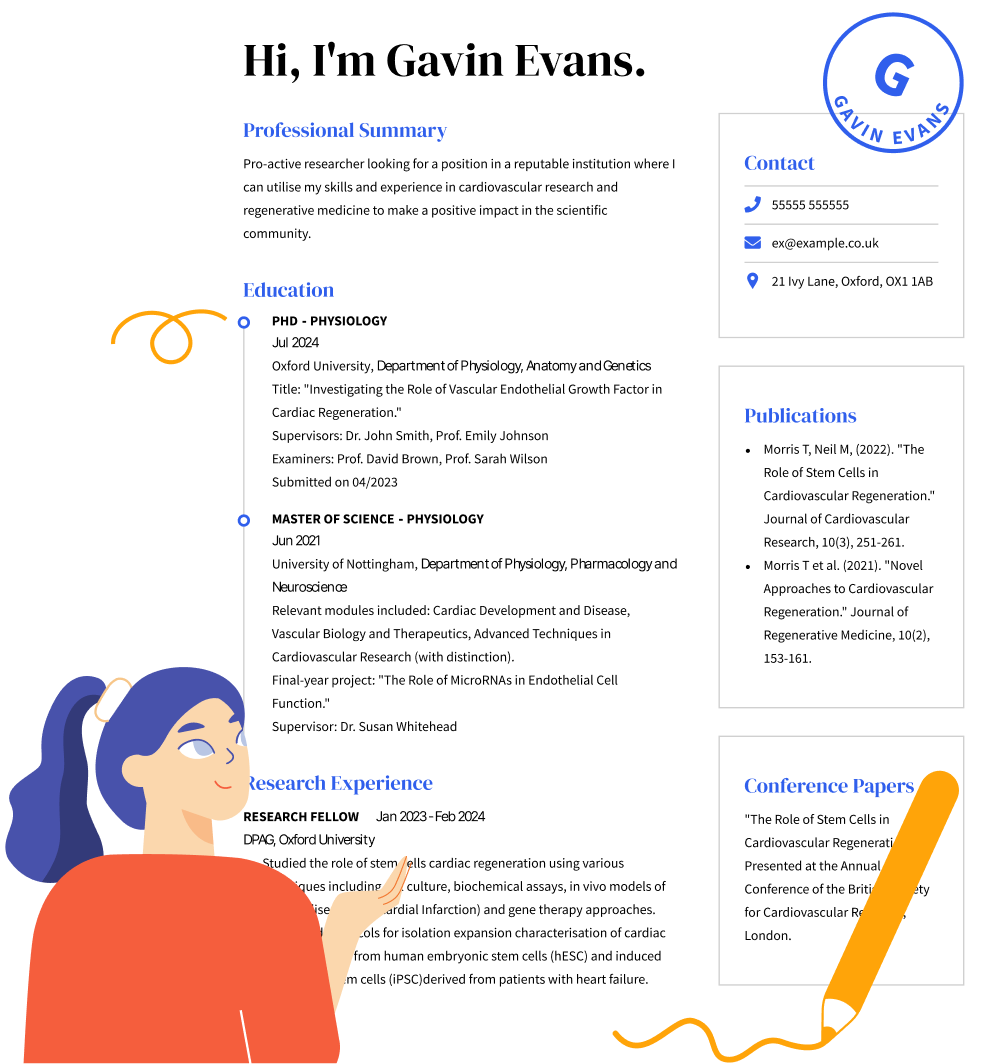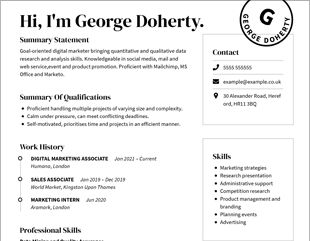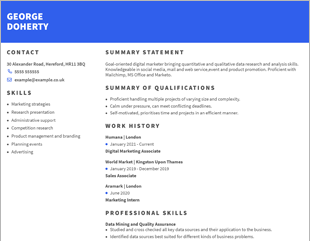Now that you know what to include in a CV, let’s take a closer look at what each section mentioned in the bullet points above should contain:
1. Name and contact details
Your full name, email address and contact number should be clearly displayed at the top of the page. Your address, age or marital status are not necessary for the application and the focus should be on your abilities, professional achievements and previous experience.
2. CV summary
A CV summary, sometimes called a personal statement or a CV profile is a short paragraph that sits at the top of your CV. You want to make it about yourself and the type of work you are interested in. While there is no exact length, between 30 and 40 words is a good guide for a personal statement.
Depending on the specific job title, you may want to tailor your CV summary to the requirements listed. If you’re changing careers, use this section to highlight that to the hiring manager.
Alternatively, if you have little or no experience, you might want to write a CV objective instead.
3. Relevant skills
If you want to add to your CV skills that are sector-specific, it’s best to state these in the skills section. This could include hard skills and technical abilities like specialist computer programs or industry knowledge, such as customer service, copywriting or stakeholder management.
Think about how you can tailor this section to the position you are applying for. You should also mention some soft skills such as communication skills, as they are transferable and are useful in many roles.
Take care to ensure that your CV is an honest portrayal of your practical experience and skills. Lying or exaggerating on your CV will become obvious during the interview.
4. Work experience
This section is the shining star of a good CV and what the recruiter will likely focus on. List your employment history, including each time the exact job title, in reverse chronological order, starting with the most recent relevant work experience first.
Include the name and postcode of the company for each of your past jobs and the employment dates that you worked there.
For each job you selected from your employment history, focus on what you brought to your role and what duties and responsibilities you had whilst there. Use active verbs to create an impact and to add action to your skills and experience.
Note that if you have more than 15 years of experience, you do not need to mention every single position you have held but only the ones that are most relevant based on the job description and your work history.
5. Education and professional qualifications
Include any higher education on your CV, as well as university degree or professional qualifications in this section. Depending on your sector, you may also want to go into more detail about your experience or any specific modules you think a recruiter may find interesting.
You don’t need to list all of your school-level qualifications in the education section. Just group these into grades and say how many of each you received, i.e., GCSEs Grade A-C (8) including maths and English.
6. Language
In today’s global and digital world, fluency in foreign languages can be a major asset for jobseekers. When applying for jobs in the UK, it is important to include a section on foreign language skills on your CV.
Always make sure to list the languages with your level of proficiency using a well-known language framework. The language you are most proficient in should appear at the top.
7. Other sections in a curriculum vitae
Hobbies and interest
This is an important part of a UK CV as it gives employers a better insight into your personality and character. This section should highlight aspects of your life outside of work that demonstrate qualities such as teamwork, creativity, and leadership.
For instance, if you have been part of a sports team or done some pro-bono work, these can be included in the hobbies section. It is also beneficial to list activities that demonstrate self-learning or knowledge acquisition, such as studying foreign languages or reading up on industry developments.
However, this section should not include irrelevant information about pastimes unrelated to the job you are applying for. Therefore, avoid listing too many hobbies, as this could detract from the main purpose of your CV which is to showcase relevant qualifications and experiences that make you the perfect candidate for the role.
Professional development
The professional development section in a CV should include any courses, seminars or workshops that you have attended to further your knowledge and skills in your chosen profession.
This section can also include any certifications or accreditations that you have achieved and are relevant to the job position. It is important to make sure that this section is kept up-to-date, as employers may look for evidence of continuous learning and improvement.
Awards
The awards section of a CV can be used to highlight any accolades or recognition that you have received in your career. This could include awards for excellence in customer service, top salesperson or employee of the year.
It is important to make sure that this section is kept up-to-date and relevant to the job position you are applying for, as it adds evidence that you are an outstanding candidate for the role. On the other hand, irrelevant awards should not be included.
Certifications
You can add a dedicated section for your certifications on a CV. It should include any qualifications, licenses, or certificates that are related to the job position. This section will provide evidence that you have the necessary skills and knowledge to succeed in the role.
If you decide to include it, make sure this section is up-to-date and relevant to the job description, as it can be a key factor for employers when making their decision. Additionally, always include details such as the date of issue and the institution issuing the certificate.
Professional membership
Professional memberships may be added as a dedicated section towards the end of your CV. Note that the best practice is for them to appear within the Education section when they are gained through examination.
Volunteer work
Finally, you can also include a section focusing on your volunteering experience. This a great way to showcase your willingness to help others and your commitment to causes.
You should always aim to frame your volunteer work on a CV in a way that demonstrates valuable soft skills such as leadership, teamwork, problem-solving abilities and communication, you have acquired while volunteering.
